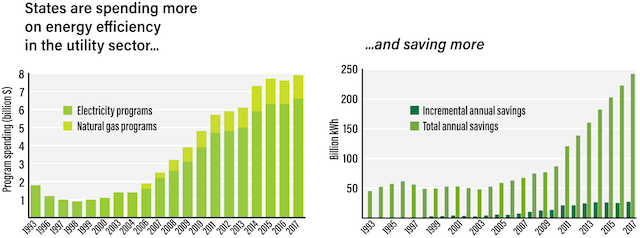ACEEE 2018 State Energy Efficiency Scorecard
October 4, 2018
Media Contact(s):
Patrick Mitchell, 703-276-3266, Hastings Group
States up efficiency investments & power savings; push net-zero buildings & electric vehicles; NJ, CT, CO, SD improve most; MA and CA lead
Washington, DC— As the US government loosens environmental rules, states are investing more in energy efficiency and delivering increased power savings, according to the 2018 State Energy Efficiency Scorecard. This 12th annual report from the American Council for an Energy-Efficient Economy (ACEEE), released today, identifies the leaders (Massachusetts and California), the most-improved states, notably New Jersey, the states that lost ground such as Iowa, and those lagging behind, including North Dakota, West Virginia, and Wyoming.
The scorecard offers mostly good news about energy efficiency — the nation’s third-largest electricity resource. In response to federal efforts to freeze US vehicle and appliance standards, quite a few states worked to retain their own standards and to promote electric vehicles as well as zero-energy buildings. While some, like Iowa and Connecticut, saw legislative attacks within their states, others — including Virginia, New York, New Jersey, Colorado, and Arkansas — unveiled plans to boost investments in efficiency and clean energy, often driven by concerns about climate change.
 ________________________________________________________________________
________________________________________________________________________
Blogger Note: Arizona had a higher rating in 2013

________________________________________________________________________
________________________________________________________________________
The scorecard, which ranks states based on 32 metrics in six areas, has these key findings:
They spent nearly $8.0 billion last year, up from $7.6 billion in 2016.
The result was a 7.3% increase in electricity savings (nearly 26.5 million megawatt-hours) — enough to power about 2.5 million US homes per year.

The scorecard offers mostly good news about energy efficiency — the nation’s third-largest electricity resource. In response to federal efforts to freeze US vehicle and appliance standards, quite a few states worked to retain their own standards and to promote electric vehicles as well as zero-energy buildings. While some, like Iowa and Connecticut, saw legislative attacks within their states, others — including Virginia, New York, New Jersey, Colorado, and Arkansas — unveiled plans to boost investments in efficiency and clean energy, often driven by concerns about climate change.

Blogger Note: Arizona had a higher rating in 2013
________________________________________________________________________
Published on Oct 4, 2018
ACEEE state policy analyst Weston Berg, lead author of the 2018 State Energy Efficiency Scorecard, discusses the report's findings.
For more information on the State Scorecard, visit http://aceee.org/state-policy/scorecard________________________________________________________________________
The scorecard, which ranks states based on 32 metrics in six areas, has these key findings:
- New Jersey improved the most, moving up five ranks to #18. The Garden State set new annual energy savings targets and took steps to rejoin the Regional Greenhouse Gas Initiative, a multistate cap and trade emissions compact. Missouri, Connecticut, Colorado, and South Dakota showed marked improvement. Other improved states include Nevada and North Carolina.
- Massachusetts continued to rank #1 overall. It launched a plan to set new three-year energy savings targets and approved utility spending for grid-scale modernization. A close second is California, which led efficiency efforts in three areas: buildings, transportation, and appliances. These leaders are followed by Rhode Island, Vermont, Connecticut, New York, Oregon, Minnesota, Washington, and Maryland.
- Iowa fell the most, moving down five spots to #24. This drop was due mostly to a bill signed earlier this year (SF2311) that imposes a restrictive cap on efficiency programs and allows customers to opt out of paying for some of them. Sixteen other states also fell in the rankings.
They spent nearly $8.0 billion last year, up from $7.6 billion in 2016.
The result was a 7.3% increase in electricity savings (nearly 26.5 million megawatt-hours) — enough to power about 2.5 million US homes per year.

- States ramped up efforts to promote zero-emission vehicles (ZEV), mostly electric, as the federal government sought to freeze fuel economy standards for cars and SUVs. California joined with eight other states in rolling out an updated ZEV plan, which incentivizes consumers to buy ZEVs. Missouri moved to incentivize the rollout of more EV charging stations, and Oregon to require new buildings be ready to charge EVs.
- More states pushed for zero-energy construction (buildings that produce as much power as they use) largely through tougher building codes. California calls for all new homes and commercial buildings to be net zero-energy by 2020 and 2030, respectively. Vermont, Rhode Island, Oregon, Washington, the District of Columbia and Massachusetts have incorporated net zero-energy construction into long-range plans.
_________________________________________________________________________
Here Are The Most — And Least — Energy Efficient States
A new report by the American Council for an Energy Efficient Economy scored each state for energy efficiency. See how your state fared.

